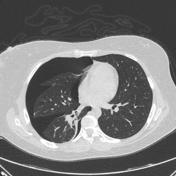Catamenial pneumothorax
Updates to Article Attributes
Catamenial pneumothorax is a rare type of pneumothorax and is characterised by the recurrent accumulation of air in the thoracic space related to menstruation.
Epidemiology
It may represent up to one-third of women with spontaneous pneumothoraces 1. Patient history may or may not be positive for previous endometriosis 10-11,11.
Pathology
While the exact mechanism is not fully understood, it is generally thought to be related to endometrial deposits from endometriosis seeding through a diaphragmatic defect or fenestration. It is thus a manifestation of thoracic endometriosis.
On video-assisted thoracic surgery (VATS), diaphragmatic defects and nodules are often found, with pathology specimens confirming endometriosis in most instances. Endometrial implants in the visceral pleura are also found, although less frequently.
Radiographic features
In general, no specific diagnostic imaging criteria exist. However, there is a right-sided preponderance 7,10-11,11.
Plain radiograph
Imaging features are often identical to pneumothoraces from other causes. Rarely, small diaphragmatic defects may be encountered ("air bubbles"), representing small perforations of the diaphragm. These may also present as a nodular appearance of the diaphragm. Cases of larger perforations presenting as basal thoracic opacities have also been described 7.
CT
May better depict above-mentioned findings. An additional possible finding is partial intrathoracic herniation of the liver 7(collar sign).
MRI
May suggest pleural-based masses attributable to endometrial implants 7.
Treatment and prognosis
Most catamenial pneumothoraces are small and self-resolving. Partial diaphragmatic resection and/or excision of visceral pleural implants, as well as talc pleurodesis, are sometimes carried out as part of treatment.
History and etymology
It was initially described in 1958 by Maurer 7. The term 'catamenial' was coined by Lillington in 1972 9 in 1972. It is derived from the Greek words pertaining to and monthly 2,10.
-<p><strong>Catamenial pneumothorax </strong>is a rare type of <a href="/articles/pneumothorax">pneumothorax</a> and is characterised by the recurrent accumulation of air in the thoracic space related to menstruation.</p><h4>Epidemiology</h4><p>It may represent up to one-third of women with spontaneous pneumothoraces <sup>1</sup>. Patient history may or may not be positive for previous endometriosis <sup>10-11</sup>.</p><h4>Pathology</h4><p>While the exact mechanism is not fully understood, it is generally thought to be related to endometrial deposits from <a href="/articles/endometriosis">endometriosis</a> seeding through a diaphragmatic defect or fenestration. It is thus a manifestation of <a href="/articles/thoracic-endometriosis">thoracic endometriosis</a>.</p><p>On video-assisted thoracic surgery (VATS), diaphragmatic defects and nodules are often found, with pathology specimens confirming endometriosis in most instances. Endometrial implants in the visceral pleura are also found, although less frequently.</p><h4>Radiographic features</h4><p>In general, no specific diagnostic imaging criteria exist. However, there is a right-sided preponderance <sup>7,10-11</sup>.</p><h5>Plain radiograph</h5><p>Imaging features are often identical to pneumothoraces from other causes. Rarely, small diaphragmatic defects may be encountered ("air bubbles"), representing small perforations of the diaphragm. These may also present as a nodular appearance of the diaphragm. Cases of larger perforations presenting as basal thoracic opacities have also been described <sup>7</sup>.</p><h5>CT</h5><p>May better depict above-mentioned findings. An additional possible finding is partial intrathoracic herniation of the liver <sup>7</sup>(<a title="Collar sign in diaphragmatic rupture" href="/articles/collar-sign-in-diaphragmatic-rupture">collar</a><a title="Collar sign in diaphragmatic rupture" href="/articles/collar-sign-in-diaphragmatic-rupture"> sign</a>).</p><h5>MRI</h5><p>May suggest pleural-based masses attributable to <a href="/articles/pelvic-protocol-for-endometriosis-mri">endometrial implants</a> <sup>7</sup>.</p><h4>Treatment and prognosis</h4><p>Most catamenial pneumothoraces are small and self-resolving. Partial diaphragmatic resection and/or excision of visceral pleural implants, as well as talc pleurodesis, are sometimes carried out as part of treatment.</p><h4>History and etymology</h4><p>It was initially described in 1958 by <strong>Maurer</strong> <sup>7</sup>. The term 'catamenial' was coined by <strong>Lillington </strong><sup>9</sup> in 1972. It is derived from the Greek words <em>pertaining to </em>and <em>monthly</em> <sup>2,10</sup>.</p>- +<p><strong>Catamenial pneumothorax </strong>is a rare type of <a href="/articles/pneumothorax">pneumothorax</a> and is characterised by the recurrent accumulation of air in the thoracic space related to menstruation.</p><h4>Epidemiology</h4><p>It may represent up to one-third of women with spontaneous pneumothoraces <sup>1</sup>. Patient history may or may not be positive for previous endometriosis <sup>10,11</sup>.</p><h4>Pathology</h4><p>While the exact mechanism is not fully understood, it is generally thought to be related to endometrial deposits from <a href="/articles/endometriosis">endometriosis</a> seeding through a diaphragmatic defect or fenestration. It is thus a manifestation of <a href="/articles/thoracic-endometriosis">thoracic endometriosis</a>.</p><p>On video-assisted thoracic surgery (VATS), diaphragmatic defects and nodules are often found, with pathology specimens confirming endometriosis in most instances. Endometrial implants in the visceral pleura are also found, although less frequently.</p><h4>Radiographic features</h4><p>In general, no specific diagnostic imaging criteria exist. However, there is a right-sided preponderance <sup>7,10,11</sup>.</p><h5>Plain radiograph</h5><p>Imaging features are often identical to pneumothoraces from other causes. Rarely, small diaphragmatic defects may be encountered ("air bubbles"), representing small perforations of the diaphragm. These may also present as a nodular appearance of the diaphragm. Cases of larger perforations presenting as basal thoracic opacities have also been described <sup>7</sup>.</p><h5>CT</h5><p>May better depict above-mentioned findings. An additional possible finding is partial intrathoracic herniation of the liver <sup>7</sup>(<a href="/articles/collar-sign-in-diaphragmatic-rupture">collar</a><a href="/articles/collar-sign-in-diaphragmatic-rupture"> sign</a>).</p><h5>MRI</h5><p>May suggest pleural-based masses attributable to <a href="/articles/pelvic-protocol-for-endometriosis-mri">endometrial implants</a> <sup>7</sup>.</p><h4>Treatment and prognosis</h4><p>Most catamenial pneumothoraces are small and self-resolving. Partial diaphragmatic resection and/or excision of visceral pleural implants, as well as talc pleurodesis, are sometimes carried out as part of treatment.</p><h4>History and etymology</h4><p>It was initially described in 1958 by <strong>Maurer</strong> <sup>7</sup>. The term 'catamenial' was coined by <strong>Lillington </strong>in 1972 <sup>9</sup>. It is derived from the Greek words <em>pertaining to </em>and <em>monthly</em> <sup>2,10</sup>.</p>
Image 2 X-ray (Frontal) ( update )

Image 3 X-ray (Frontal) ( update )

Image 4 CT (lung window) ( update )

Image 5 X-ray (Frontal) ( create )








 Unable to process the form. Check for errors and try again.
Unable to process the form. Check for errors and try again.